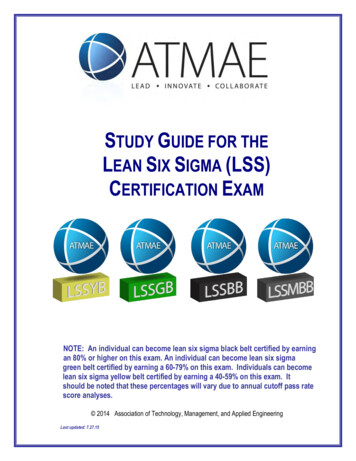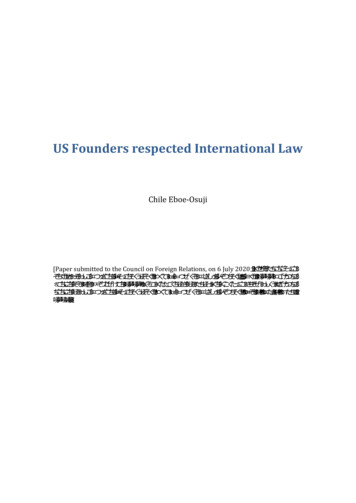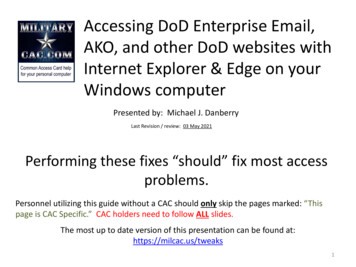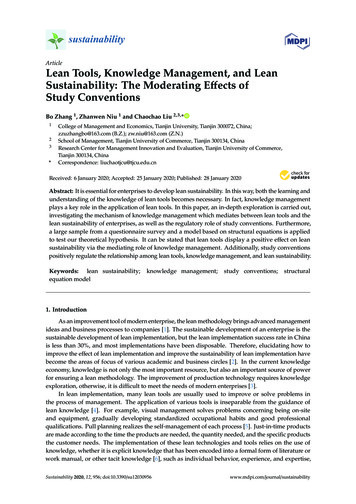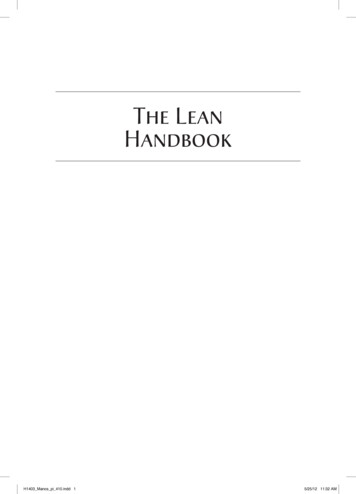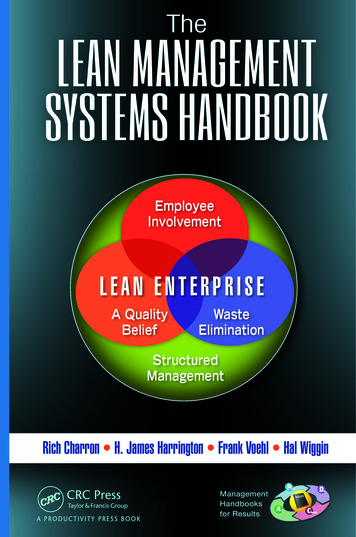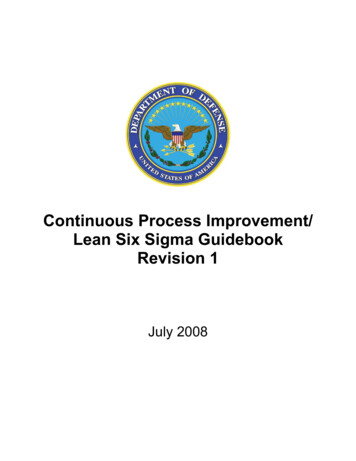
Transcription
Continuous Process Improvement/Lean Six Sigma GuidebookRevision 1July 2008
Letter to Our ReadersThe original DoD Continuous Process Improvement (CPI) Transformation Guidebook was published in May 2006. The Deputy Secretary of Defense, in the Guidebook’s cover memo, endorsed it as a resource for all DoD organizations to help design and manage CPI efforts and tofoster a culture of continuous improvement throughout the Department.This July 2008 CPI/Lean Six Sigma (LSS) Guidebook updates the May 2006 document. It reflects the inputs of a cross-agency DoD team as well as major developments that demonstratefurther institutionalization of a CPI/LSS culture within the DoD. We have placed additional focus and emphasis on adapting continuous process improvement principles and implementingLean Six Sigma and other effective methodologies.I am proud and honored to be the first Director of the DoD CPI/LSS Program Office, which theDeputy Secretary established in April 2007. Our collective initiatives represent the largest continuous improvement deployment ever attempted. Engaged leadership, clear-cut objectives, highimpact projects, rigorous tracking, and a strong recognition program are keys to driving CPI/LSSacross DoD.Continuous process improvement is being carried out through our focus on these leverage pointsfor cultural change - unfettered by restrictive rules. We have not attempted to dictate how yourorganizations go about improving their processes, nor do we intend to. We recognize there aremany ways to pursue your goals. Our interest is in providing a relevant framework to help youget there a framework through which complicated processes can be examined in an organizedand understandable fashion.This updated Guidebook can be an effective reference document for any organization. It definessome major features we would like to see within the DoD process improvement structure, but italso provides appropriate latitude for Service/Agency implementation of those features.I look forward to working with you all to sustain and accelerate your efforts. We are working toenable our workforce to solve problems using a culture changing methodology one person andone project at a time.J.D. Sicilia, Director, DoD CPI/LSS Program Office
DRAFT—September 20062
ContentsSection 1. CPI in DoD. 1-1Overview. 1-1Structure and Use of This Guidebook. 1-3Section 2. DoD CPI Framework . 2-1Area 1—Fundamental Concepts of CPI . 2-2CPI “Musts” . 2-3CPI Principles . 2-3A Value Stream Focus Within the Enterprise. 2-4CPI Culture . 2-5Area 2—The CPI Deployment Cycle . 2-5Develop Vision, Mission, and Strategy (Fig. 2-2, Block 1) . 2-6Conduct a Value Stream Analysis (Fig. 2-2, Block 2) . 2-8Develop Structure and Behavior (Fig. 2-2, Block 3) . 2-9Align and Deploy Goals (Fig. 2-2, Block 4). 2-10Create and Refine Operational Plan (Fig. 2-2, Block A). 2-11Implement Operational Plan (Fig. 2-2, Block B). 2-11Monitor Progress (Fig. 2-2, Block C) . 2-11Focus on CPI (Fig. 2-2, Block D) . 2-11Re-Entry. 2-11Area 3—Operational Plan. 2-12Area 4—Change Management. 2-12Area 5—Metrics. 2-14Leading Metrics versus Lagging Metrics . 2-14Customer-Oriented, Outcome-Based Metrics. 2-14Criteria for Evaluating Metrics . 2-15v
Section 3. CPI Roles and Responsibilities. 3-1Primary Roles. 3-1CPI Champions . 3-2CPI Steering Committees. 3-5CPI Support Teams . 3-9CPI Work Groups . 3-13CPI Peer Groups . 3-16Other Important Roles and Responsibilities . 3-16IT Personnel and Vendors. 3-16Contracting. 3-16Facilities Management . 3-17Human Resources . 3-17Supply . 3-17Labor Unions . 3-17Finance. 3-17Engineering . 3-18Attachment A. ResourcesAttachment B. Organizational Implementation Planning FrameworkAttachment C. Training and CertificationAttachment D. CPI Progress AssessmentAttachment E. CPI ToolboxAttachment F. Guides, Checklists, and Project ChartersAttachment G. TerminologyAttachment H. DoD Certification Processvi
ContentsFiguresFigure 1-1. Guidebook Overview . 1-2Figure 1-2. Guidebook Structure . 1-3Figure 2-1. Value Streams and the DoD Enterprise . 2-4Figure 2-2. CPI Deployment Cycle . 2-6Figure 2-3. Strategic Deployment. 2-7Figure 2-4. Generic Example of Value Stream Map for Weapon System. 2-9Figure 2-5. CPI Implementation Structure. 2-10Figure 3-1. Key CPI Champion Activities. 3-3Figure 3-2. Key CPI Steering Committee Activities . 3-6Figure 3-3. Key CPI Support Team Activities. 3-10Figure 3-4. Key CPI Work Group Activities . 3-14vii
viii
Section 1.CPI in DoDOverviewDoD is achieving significant performance improvements in its full range of activities—from operations to human resources management and logistics management—with the major focus onimproving the support for the warfighter customer by applying Continuous Process Improvement(CPI) concepts and tools. Lean Six Sigma (LSS) is an important part of the Department’s CPIeffort. A disciplined improvement methodology, LSS has been endorsed by DoD leadership as aprimary means by which the DoD will become more efficient in its operations and more effective in its support to the warfighter. The DoD has embraced LSS and a broad range of tools andmethods to strategically approach development of a culture of continuous improvement in theareas of process cycle times, resource consumption, quality, and other aspects of productivity.For example, the Air Force applied CPI to reduce the repair cycle time for C-5 aircraft by33 percent with an eventual goal to reduce total repair cycle time by over 50 percent. The Navy’sSurface Warfare Center carried out LSS projects in administrative, manufacturing, and researchand development functions to net nearly 9 million in savings over 3 fiscal years. The Army received tremendous payback because of LSS, saving 30 million on its HMMWV line. The benefit was not only in cost savings, but also in the number of vehicles delivered to the soldiers whoneeded them. The Defense Logistics Agency (DLA) reduced interest payments and administrative lead times on a major support contract by 10 percent through lean and Six Sigma techniques.DLA is currently applying these techniques to improve Common Access Card (CAC) issuancerates. These successes, and many others like them, demonstrate the DoD’s ability to apply worldclass, best-of-breed practices to meet a wide range of operational requirements.Secretary England’s memo emphasizes the importance of CPI and LSS and the need to codifyand share experiences across the Department and beyond. This guidebook is intended to facilitateCPI success from implementation through sustainment. CPI’s promise across the DoD as well asother public- and private-sector organizations relies upon the creation of an overriding culturethat totally embraces continuous improvement as an everyday way of addressing all work efforts.Success rests with a mindset to attack problems and identify practical opportunities for improvement. This guidebook is a resource to be used throughout the Department for designing,managing, and sustaining CPI and LSS efforts.This guidebook provides a framework to be used for implementing and sustaining a culture ofcontinuous improvement (see Figure 1-1).1-1
Figure 1-1. Guidebook OverviewCommon CPI projectidentification,tracking, andmanagementBroad-based,structured CPImethodologyCPI“Islands ofExcellence”CPIFocus upon aligned,warfighter-focusedmetricsCPI“Step Change”SuccessConvergence uponterminology,training, and CPIcertificationIt focuses on the following four key elements of CPI that require a common understanding andsupport to facilitate ongoing process improvement initiatives and set the stage for greater enterprise-level improvements:x A broad-based, structured CPI implementation method that spotlights why a sound improvement plan is needed and how to determine and implement the best solution. This involves strategic planning at the enterprise level to properly focus improvement activities,and operational planning at the organizational level to achieve aligned performance improvement across the enterprise value chain. The methodology describes stakeholder keyroles and responsibilities in supporting, monitoring, and repeating the improvement process. It also includes the use of peer groups to benchmark activity and cross-fertilize bestmanagement practices across the DoD. This methodology is a baseline and referencemechanism for continual refinement and application.x A focus on CPI implementation within a structure of goals that are aligned to awarfighter-driven, outcome-based metric. Goals that are pursued and achieved in eachCPI and LSS project should be measured by results-oriented performance metrics thatsupport customer requirements most effectively in terms of time, quality, and cost. CPIprojects should strategically align with an organization’s results-oriented metrics—suchas measures related to the Government Performance and Results Act (GPRA)—to ensure the optimal impact on the enterprise value stream. Improved reliability, reducedprocess cycle times, and a focus on targeted effectiveness at lowest total cost are drivingelements of improvement efforts.x Emphasis on the management and integration of CPI projects. CPI projects requirean effective project management approach to achieve results and encourage synergywithin the DoD culture at large. This guidebook provides a format for initiating, tracking, and evaluating CPI and LSS improvement, inc
Lean Six Sigma (LSS) is an important part of the Department’s CPI effort. A disciplined improvement methodology, LSS has been endorsed by DoD leadership as a primary means by which the DoD will become more efficient in its operations and more effec-tive in its support to the warfighter. The DoD has embraced LSS and a broad range of tools and methods to strategically approach development of a .
